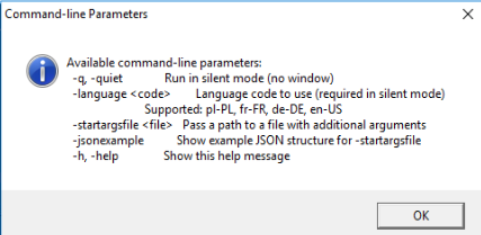To use installation parameters in silent mode, run the cmd.exe command prompt with administrator privileges.
UpdateAgentSetup_Parent.exe – for the parent agent The commands are different.
The -help / -h command provides access to a list of available commands and their functionalities, e.g.:
UpdateAgentSetup.exe -h
UpdateAgentSetup_Parent.exe -h

Using the -jsonexample command, you can view the JSON file structure required to configure the agent. Using -q ensures that this structure is displayed in the console view instead of a new window, e.g.:
UpdateAgentSetup.exe -q -jsonexample
Contents
Sample JSON structure for -startargsfile:
{
“AgentBinPath”: “path to the AutoUpdate installation directory”,
“AgentCode”: “customer code”,
“AgentType”: “Agent0”,
“BackupDirectory”: “path to the directory where the backup is stored”,
“Culture”: “language setting in a supported format (e.g. pl-PL, fr-FR, de-DE, en-US)”,
“DownloadDirectory”: “path to the directory where AutoUpdate saves downloaded files”,
“InstallDirectory”: “path to the directory where AutoUpdate installs all components”,
“ManuallyLaunched”: true,
“PathToCertificates”: “path to the .zip file with certificates from the parent agent (used only when AutoUpdate already runs in SSL mode)”,
“RemoteHostName”: “address of the parent agent”,
“RemotePortNumber”: “port for communication with the parent agent via REST (default 11365 for subordinate agent)”,
“ServerPort”: “port used by AutoUpdate for communication with the user interface (default 11365)”,
“SslParentPort”: “SSL port for communication with the parent agent (for subordinate agent this is the SSL port set on the master agent, default 12365)”,
“UseSsl”: true, if AutoUpdate runs in SSL mode; false, if not,
“UiPort”: “port used by the AutoUpdate user interface for communication with the service (default 8010)”,
“CreateDesktopIcon”: true, if the installer should create a desktop shortcut; false, if not,
“RabbitSwitchedToSsl”: true, if RabbitMQ already runs in SSL mode; false, if not.
}
Sample JSON code for a child agent in a REST network:
{
“AgentType”: “Agent0”,
“IsRoot”: false,
“AgentBinPath”: “C:\Program Files (x86)\Comarch Auto Update”,
“AgentCode”: “TEST_CHILD”,
“Culture”: “pl-PL”,
“ManuallyLaunched”: true,
“CreateDesktopIcon”: true,
“DownloadDirectory”: “C:\Comarch Auto Update\Downloads\”,
“BackupDirectory”: “C:\Comarch Auto Update\Backup\”,
“InstallDirectory”: “C:\Program Files (x86)\”,
“RemoteHostName”: “TEST_MAIN”,
“RemoteTcpPortNumber”: 8009,
“RemotePortNumber”: 11365,
“LocalChildHostName”: “localhost”,
“LocalChildPort”: 11366,
“LocalParentHostName”: “localhost”,
“LocalParentPort”: 8009,
“ServerPort”: 11365,
“UiPort”: 8010
}
“AgentType”: “Agent0”,
“IsRoot”: false,
“AgentBinPath”: “C:\\Program Files (x86)\\Comarch Auto Update”,
“AgentCode”: “test”,
“Culture”: “pl-PL”,
“ManuallyLaunched”: true,
“CreateDesktopIcon”: true,
“DownloadDirectory”: “C:\\Comarch Auto Update\\Downloads\\”,
“BackupDirectory”: “C:\\Comarch Auto Update\\Backup\\”,
“InstallDirectory”: “C:\\Program Files (x86)\\”,
“RemoteHostName”: “TEST_MAIN”,
“RemoteTcpPortNumber”: 8009,
“RemotePortNumber”: 11365,
“LocalChildHostName”: “localhost”,
“LocalChildPort”: 11366,
“LocalParentHostName”: “localhost”,
“LocalParentPort”: 8009,
“ServerPort”: 11365,
“UiPort”: 8010,
“UseSsl”: true,
“PathToCertificates”: “C:\\AU\\certificate_for_child.zip”,
“SslParentPort”: 12365,
“RabbitSwitchedToSsl”: true
}
Example of child agent installation command:
Sample JSON code for parent agent installation:
{
“AgentType”: “Agent0”,
“IsRoot”: true,
“AgentBinPath”: “C:\Program Files (x86)\Comarch Auto Update”,
“AgentCode”: “test_CHILD”,
“Culture”: “en-US”,
“ManuallyLaunched”: true,
“CreateDesktopIcon”: true,
“DownloadDirectory”: “C:\Comarch Auto Update\Downloads\”,
“BackupDirectory”: “C:\Comarch Auto Update\Backup\”,
“InstallDirectory”: “C:\Program Files (x86)\”,
“RemoteHostName”: “update.comarch.com”,
“RemoteTcpPortNumber”: 8009,
“RemotePortNumber”: 9466,
“LocalChildHostName”: “localhost”,
“LocalChildPort”: 11366,
“LocalParentHostName”: “localhost”,
“LocalParentPort”: 8009,
“ServerPort”: 11365,
“UiPort”: 8010
}
